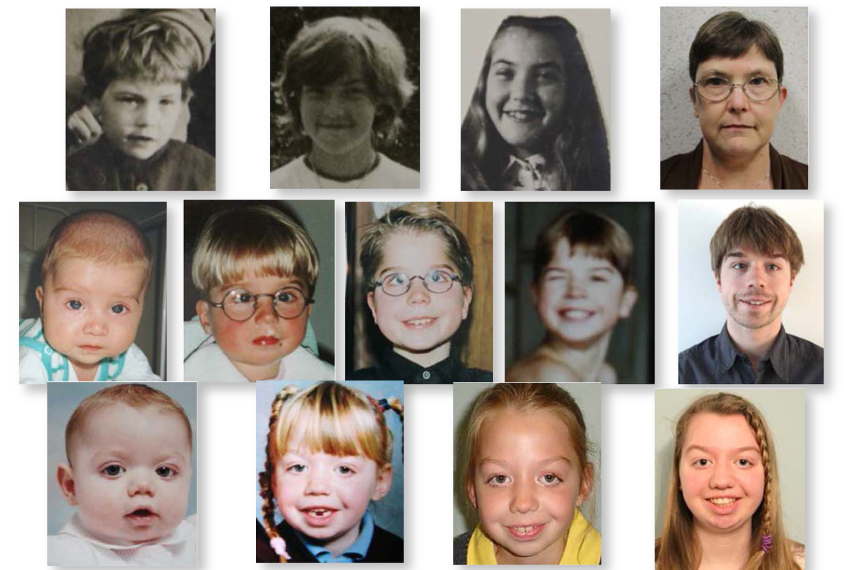
THIS ARTICLE IS MORE THAN FIVE YEARS OLD
This article is more than five years old. Autism research — and science in general — is constantly evolving, so older articles may contain information or theories that have been reevaluated since their original publication date.
Mutations in an autism-linked gene called AUTS2 do not cause the condition’s core social features, according to the most comprehensive clinical portrait to date1. However, the mutations almost always lead to intellectual disability.
Deletions in AUTS2 trigger a constellation of symptoms, including small head size, developmental delay and facial features such as arched eyebrows and a small chin. About 1 in every 2,000 people with intellectual disability or multiple birth defects are missing parts of the gene. Researchers have also identified AUTS2 variants in people with autism2.
The new study suggests that autism is an uncommon consequence of changes in AUTS2. About 83 percent of the individuals in the study show repetitive behaviors associated with autism, but none exhibit the social communication problems required for an autism diagnosis. All of the people have mild to severe intellectual disability.
“They do not have classical autism,” says lead researcher Erik Sistermans, head of genome diagnostics at Vrije University Medical Center in Amsterdam. “In childhood, we even see hypersocial behavior and lack of inhibition in social contact to strangers.”
The report, which appeared in April in the Journal of Medical Genetics, provides the first glimpse of AUTS2 syndrome in adults. Most adults with AUTS2 deletions have no chronic health issues, it revealed.
“While the sample size is small, the data are very important for clinical genetic predictions,” says Stephen Scherer, director of the Centre for Applied Genomics at the Hospital for Sick Children in Toronto, who was not involved in the work.
Easy interaction:
A team led by Sistermans first described AUTS2 syndrome in 2013, based on 24 children. That inspired clinicians around the world to phone in their own accounts of people with the mutations.
Researchers have identified 50 people with AUTS2 syndrome thus far, but most clinical reports are still based on just 1 or 2 children.
The new study includes 10 newly identified individuals and 3 from the 2013 study, ranging in age from 11 months to 59 years. Although the researchers did not use a diagnostic test for autism, they examined each person and collected medical histories. They also looked at AUTS2 sequences in the participants and, where possible, in their parents to decode the inheritance patterns.
They found that all but two of the participants have an unusually small head, or microcephaly, consistent with previous work. Most of the individuals also have repetitive behaviors.
However, none of them have difficulties with social interaction or communication, two of the three criteria for an autism diagnosis in the International Classification of Diseases-10, the World Health Organization’s diagnostic bible. The children interact easily with familiar and unfamiliar people; the adults tend to be shy and reserved, but can communicate in social situations.
The weak link between AUTS2 and autism is not surprising, says Santhosh Girirajan, assistant professor of biochemistry and molecular biology at Penn State University in University Park, Pennsylvania, who was not involved in the work. One theory posits that individual autism symptoms, such as repetitive behaviors, stem from distinct genetic causes. It is possible that AUTS2 offers just one of the multiple genetic ‘hits’ needed to cause autism, he says.
Genetic origins:
By contrast, mutations in the gene show a strong link to intellectual disability. All 13 individuals have some degree of cognitive disability, based on tests of intelligence.
The researchers also uncovered clues about the genetic origins of this trait. As previous work shows, deletions near the end of the AUTS2 sequence lead to severe intellectual disability, whereas those near the beginning of the gene produce mild disability. The researchers found that deletions near the end of AUTS2 are usually spontaneous, and those near the beginning of the gene tend to be inherited from a mildly affected parent.
Intellectual disability is a stable trait, but a number of developmental and health issues that crop up in early childhood seem to disappear later. For example, as children, most of the participants walked late, had difficulty chewing, swallowing or digesting food, and had frequent infections, but these problems resolved by age 6.
As adults, most have mild skeletal defects, such as scoliosis. Two of the adults have epilepsy and one has lupus, but it’s unclear whether these conditions are tied to AUTS2 deletions. Adults with AUTS2 syndrome have no other chronic health problems.
“This is very important for genetic counseling,” Sistermans says. “It is important for parents to know that these children do not really deteriorate, that [the syndrome] is rather stable once they grow up.”
By joining the discussion, you agree to our privacy policy.